Are you staring down a bowl of what was supposed to be smooth, creamy goodness, but instead, you’re faced with a lumpy catastrophe? Don’t despair! I will give you some effective tips on how to get lumps out of mashed potatoes. Whether those tenacious clumps formed from boiled potatoes or you’re attempting to salvage instant mashed potatoes from meeting a chunky end, this is your lifeline.
In this article, we’ll dive into the practical ways to smoothen out lumps from both freshly-made and instant mashed potatoes, ensuring that you are equipped to tackle both scenarios.
I am not just here to rescue your current batch, but I’ll also share some nuggets of wisdom to keep those lumps at bay in the future. So, grab your potato masher, put on your game face, and let’s get those mashed potatoes back on track!
Read Also: 5 Creative Ways to Fix Salty Mashed Potatoes – (Do Not Add Sugar!)
Why Are My Mashed Potatoes Lumpy?

I know the urge to address those irritating lumps in your mashed potatoes swiftly is strong, but let’s pause on that potato masher for a moment. Before we dive into the lump-banishing tactics, let’s understand how those tenacious lumps made their way into your mashed potatoes in the first place, as it is a lot easier to present them than mess about later trying to get rid of them.
In the realm of lumpy mashed potatoes, there are three key players that I will list below that can turn your silky-smooth mash into a chunky affair. Each of them can be the hidden saboteur, secretly making your mashed potatoes less than perfect.
By gaining insights into the origin of those undesirable lumps in your mashed potatoes, you’ll be better equipped to guard against them. Knowledge is power – wield it to conquer the lumpy mashed potato predicament and achieve the smooth, creamy mashed potatoes of your dreams.
Without further ado, let’s unveil these troublemakers:
1. Undercooked Potatoes

Suppose you’re making a big batch of mashed potatoes and have lots of spuds of all sizes and shapes cooking. In such case, you risk uneven cooking times—some potatoes will be ready much faster than others, which may still be undercooked.
This means that some hard bits will be much harder to crush when you make mashed potatoes. The result? Lumpy mashed potatoes with a creamy texture interrupted by hard chunks.
But that said, you don’t want to overcook your potato eater so that they would fall apart and become watery and soupy. To prevent that read these instructions here: How To Boil Potatoes Without Them Falling Apart (6 Effective Tips).
2. Wrong Potatoes

There are many, many types of potatoes, and they are very different from one another. Some are waxy, some are starchy, and not all of them are good for making mashed potatoes.
Your best bet would be Yukon Gold potatoes, as they have plenty of starch—which makes smashed potatoes fluffy and soft—but not too much, which can turn mashed potatoes crumbly or gluey.
Russet potatoes are another popular choice, but you need to be careful not to overcook them, as they can absorb lots of water and could turn gooey. Likewise, if undercooked, they can be prone to lumps.
3. Wrong Mashing Method
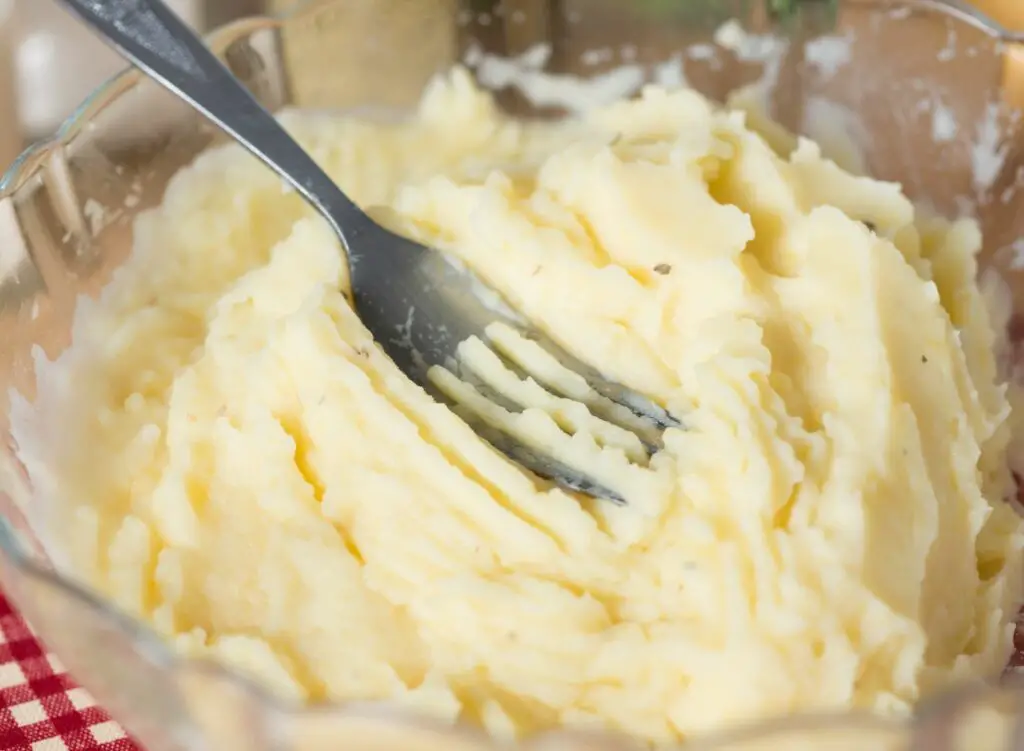
If you’re fond of mashing potatoes with a fork, it’s time to let it go and put it in the sink—it’s a recipe for disaster.
Forks are too small to mash potatoes properly—even more so if there are lots of them—which always leads to lumps and not the silky, creamy dish you imagine.
Likewise, stand mixers are popular for aerating potatoes and making them fluffy, but they are not the best for making a lump-free preparation. Even worse, you risk overworking the potatoes and turning them sticky and gooey while still having some chunks here and there.
How To Get Lumps Out Of Mashed Potatoes

Of course, there’s nothing wrong with lumpy mashed potatoes—I bet your food is still yummy, and some lumps are just part of life.
However, if you’d like to fix it, you have three major methods to consider: crush, cook, or hide the lumps.
Let me give you a few good ways to do each of them.
1. Crush With A Potato Ricer
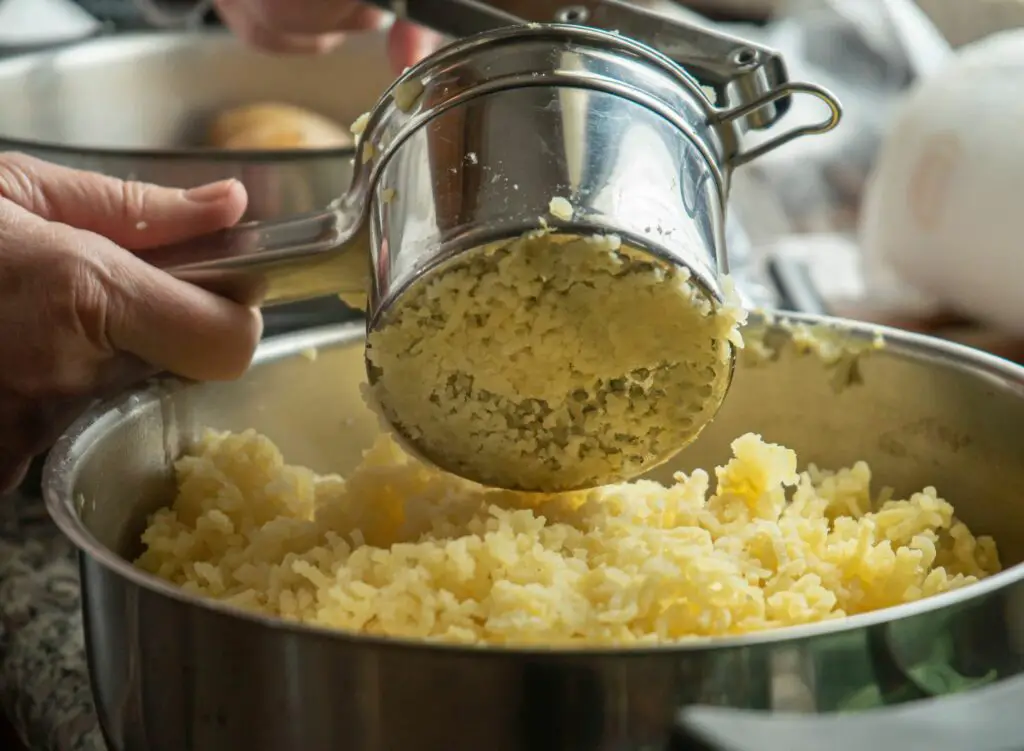
The potato ricer is the trick that I have often used for perfectly creamy mashed potatoes each time, guaranteed, without a single lump in sight!
It works because a potato ricer uses brute force to make all that delicious potato goodness go through a set of tiny holes, thus crushing any potential lump and ensuring the mashed potatoes are perfectly even.
Overall, I highly recommend using a potato ricer each time you plan to make mashed potatoes—it’s fast, easy, and highly efficient. If you haven’t purchased one, I advise using the stainless steel options with different interchangeable discs like the one below.
One of the few downsides of using a potato ricer is time—filling it with potatoes each time can be a slow process, and making a big batch can take a long time.
Likewise, you will need some hand and arm strength to crush the potatoes, which may be hard for people with arthritis and other health issues.
2. Use A Food Processor
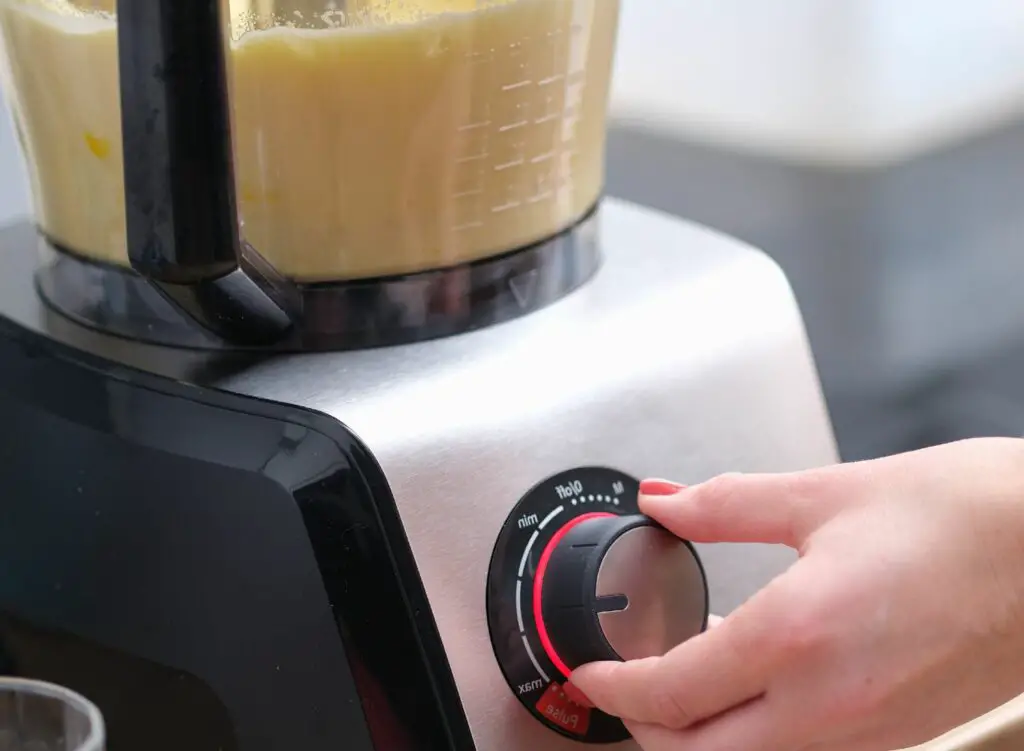
If you do not have a potato ricer, you could use a food processor. Although it seems like an easy fix, it’s a risky method that can go wrong fast. Over-blending means overworking the potatoes, releasing lots of starch, and a gluey, sticky mess.
It’s very easy to overwork your mashed potatoes, so your best bet would be to use the food processor only on the lumps and for concise and fast bursts. Scoop the lumps out and place them inside the food processor, then blend for a second or two.
Working with only the lumps prevents potential damage to the rest of your mashed potatoes if you were to overwork it, but it also means it works only if there are lots of lumps to work with.
In my opinion, this method has many risks, so it’s best to keep it as a last resort.
3. Cook A Bit More
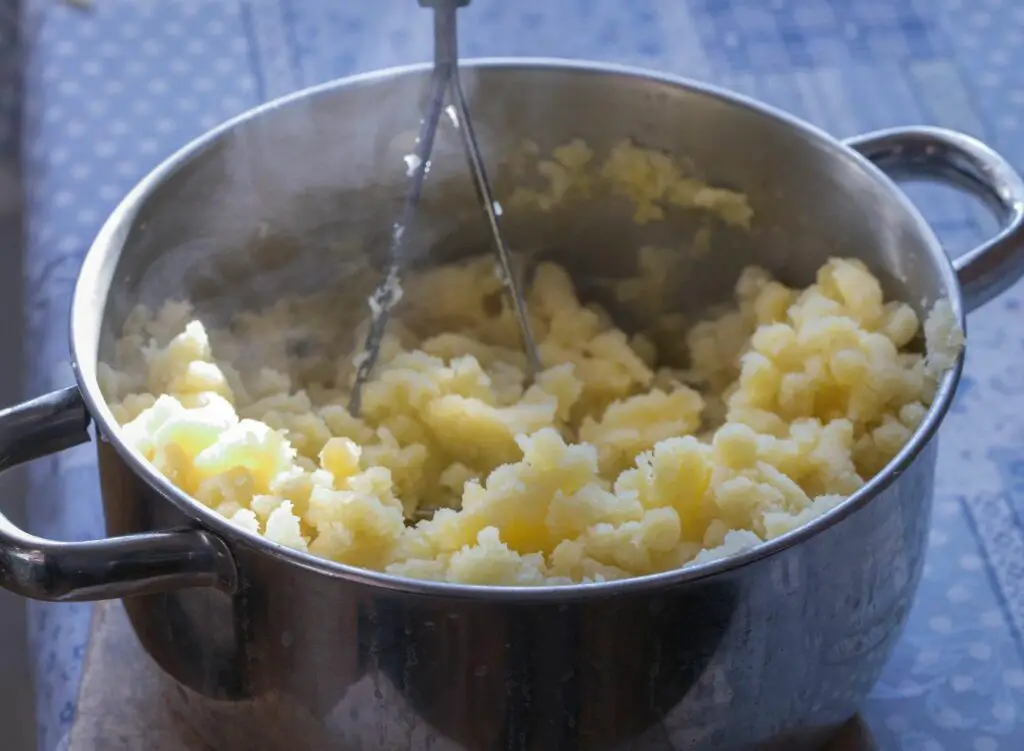
Remember how I mentioned the lumps come from undercooked potatoes? This method relies on trying to cook the hard bits again to get them soft and fluffy like the rest of the preparation.
First, you should add a tiny bit of liquid into a pan over low heat. Although water and dairy work best—particularly milk or cream—you can use any option, including broth or milk alternatives.
Once the liquid heats up but without reaching boiling point, scoop out the lumpy bits from your mashed potatoes and add them to the pan. Pay attention to it and gently mix and mash until it turns smooth. After you consider it done, feel free to add it back to the preparation.
However, what if there’s a sea of tiny lumps scattered throughout your mashed potatoes, and scooping them all out is simply not practical?
In such cases, consider adding hot liquid directly to the mashed potatoes is another method to help smooth out lumps.
Here’s how you can do it:
- Heat the Liquid: Start by heating up your liquid of choice (milk, cream, broth, or a dairy alternative) in a saucepan or microwave until it’s hot but not boiling.
- Add Hot Liquid to the Mashed Potatoes: While keeping the mashed potato on low heat, gradually add the hot liquid to your lumpy mashed potatoes while continuously stirring or mashing. The l0w heat and the hot liquid will help soften the potato lumps and make them easier to mash.
- Mash or Whip Vigorously: Use a potato masher, fork, or electric mixer to vigorously work through the mashed potatoes. This will help break down the lumps.
- Strain if Necessary: If, after adding the hot liquid and mashing, you still find stubborn lumps, you can press the mashed potatoes through a fine sieve or use a potato ricer to achieve an ultra-smooth texture.
- Season and Serve: Once you’ve achieved the desired smooth texture, do a final taste test and season your mashed potatoes with salt, pepper, or any additional flavorings as needed. Serve your now lump-free mashed potatoes hot.
4. Use A Microwave
Here’s how to get lumps out of mashed potatoes using a microwave:
- Add Liquid: Stir in a small amount of hot milk, cream, or butter to your lumpy mashed potatoes to loosen them up.
- Microwave: Place the bowl of mashed potatoes in the microwave. Heat them on high for about 30 seconds.
- Stir and Assess: Take the bowl out (be cautious, it may be hot) and give the mashed potatoes a good stir. Check the consistency and feel for lumps.
- Repeat if Necessary: If the mashed potatoes are still lumpy, heat them for another 30 seconds, then take them out and stir vigorously. Use a fork to try to break up any remaining lumps.
- Final Touches: Once smooth, check the seasoning and add salt, pepper, or additional butter to taste.
Please note that microwaving can sometimes make mashed potatoes gluey if overdone, so it’s important to do this in short intervals and avoid overheating.
5. Camouflage the Lumps
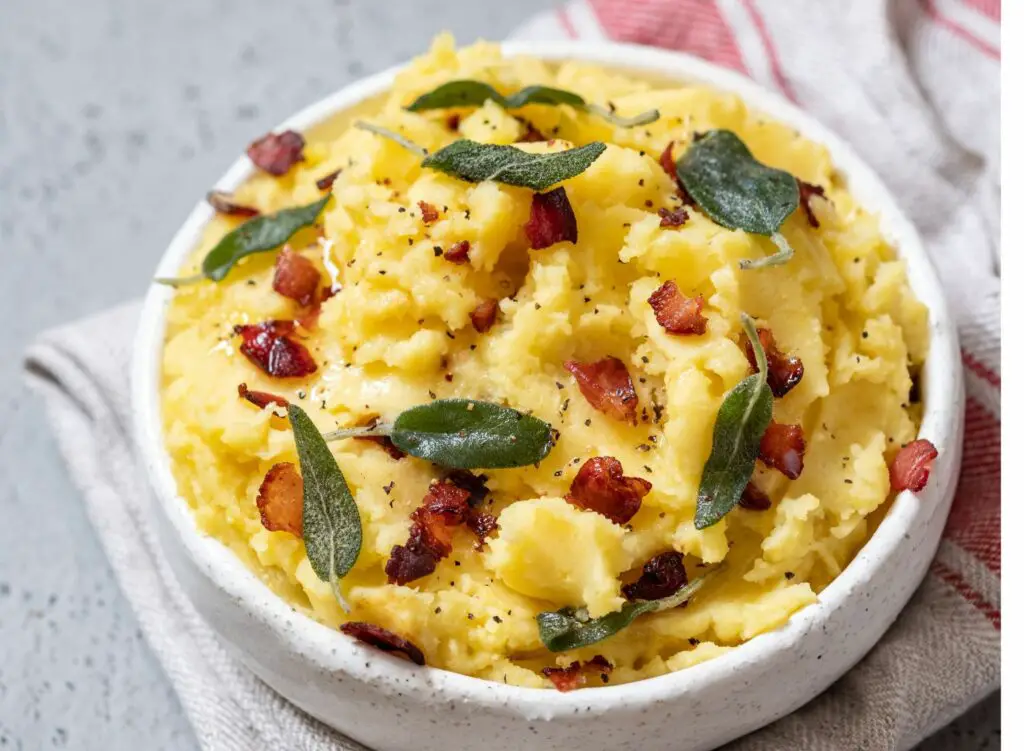
Sometimes, despite our best efforts, those stubborn lumps just refuse to leave our mashed potatoes. If you’ve exhausted other smoothing methods and painstakingly crushing each lump is not on your agenda, worry not.
I have a savvy solution: hide the lumps! Masking the textural contrast between the creamy mashed potatoes and the pesky lumps can turn a supposed flaw into a delightful feature.
Here are my favorite tips on how to employ this culinary stealth mode:
- Choose Your Allies: First, pick ingredients that have a certain chunkiness or texture to them. These will be your allies in hiding the lumps. Think of options like crispy bacon bits, chopped green onions, grated cheese, or even caramelized onions.
- Prepare the Ingredients: Cook or prepare the ingredients as necessary. For example, if you’re using bacon, cook it until it’s crispy and then crumble it into small pieces. If using green onions or chives, chop them finely.
- Blend Them In: Gradually mix your chosen ingredients into the mashed potatoes. Make sure they are evenly distributed. The goal here is to create a mosaic of textures so that the original lumps camouflage effortlessly amidst the new additions.
- Taste and Adjust: As you add these textural ingredients, they will also impart flavor to the mashed potatoes. Taste the mix and adjust the seasoning as needed. You might want to add some extra salt, pepper, or even a dash of garlic powder for an added flavor punch.
- Embrace the Texture: Remember, not everyone dreams of perfectly smooth mashed potatoes. Many find joy in a dish with a bit of texture. By adding these ingredients, you’re not just hiding the lumps but transforming your mashed potatoes into a rich, hearty side dish with layers of flavor and texture.
- Present with Panache: Finally, the presentation can also play a part in camouflaging lumps. Garnish your mashed potatoes with a sprinkle of fresh herbs, an extra scattering of crispy bacon, or a drizzle of melted butter. This will make the dish look so enticing that no one will be focused on finding lumps.
By embracing the lumps and harmonizing them with other textures and flavors, you’ve artfully turned a potential mishap into a triumphant culinary creation. And who knows, your mashed potatoes with a twist might just become the new favorite at the table!
Read Also: Why Use Cream Cheese In Mashed Potatoes? (Taste, Texture, And Recipe).
How To Prevent Lumps From Forming In Mashed Potatoes?

Mission complete—you fixed the mashed potatoes, and your meal was a hit with everyone who tried it. Now, the next step is trying to prevent the problem from happening again.
Luckily, I have plenty of tips that you can follow to ensure your mashed potatoes are always smooth, silky, and lump-free.
- Try to work with Yukon Gold or Russet potatoes if you want to mash them.
- Use fresh potatoes as older potatoes have been exposed to air for longer and can sometimes have a grittier texture. Using fresh potatoes can ensure a smoother mash.
- Cut all potatoes symmetrically, ensuring each piece is roughly the same size and thickness.
- Put potatoes in cold water before boiling. Never place potatoes inside a pot of boiling water.
- Monitor the potatoes closely to ensure potatoes don’t overcook and fall apart.
- Avoid using forks or mixers to blend the potatoes.
- Sift through for the unexpected lumps early. As you start mashing, if you find any particularly hard lumps, it’s a good idea to remove them early in the process. Sometimes, a few pieces may not cook as evenly as the others.
- When it’s time to add liquid to the potatoes, make sure it is never cold. Heated-up ingredients work best.
If you follow these tips, I can guarantee lumps will never threaten the smoothness of your mashed potatoes ever again.


